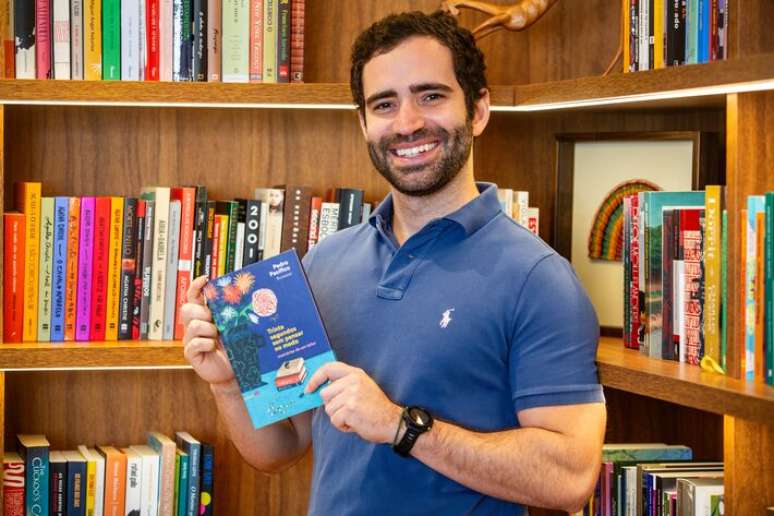‘Estadão’ explored the collection of the lawyer, who has gone from anonymity on social media to a ‘literary influencer’. Methodically, he explains how he orders copies, gives advice on what to read and talks about his first book, ‘Thirty Seconds Without Thinking About Fear’
“Double-edged sword” is an expression that well defines the relationship between books AND social media. It is a fact that their excessive use takes away time that we could dedicate to reading. But at the same time a generation of new readers is being forged literary influencerswhich give advice on what to read and how to read. The lawyer Pedro PacificoOR ‘Bookseller‘ to his followers, he decided to follow the second path.
“We see that phenomena such as ‘BookTok‘ [corrente de vídeos sobre literatura no TikTok] have generated impacts on sales. Many times people think they don’t like reading, but in reality they are simply lost in their reading choices,” Pacifico says. He received the report from State in his apartment in St. Paul to showcase the details of your personal library, which has already become background and reference in the videos you record for your profiles.
Pacifico has reached much more than just friends or acquaintances. After an anonymous debut with the nickname ‘bookster’, he has lost the shame of reconciling his formal profession with his life as an influencer. In total, there are almost 700 thousand followers Instagram, Tick tock, Youtube AND X. “I have to receive on average five books a day, which publishers and authors send me. I try to distinguish between what I keep and what I give away. I can’t even read 1% of what I receive.”
How to organize your book collection?
When Pedro Pacifico opens the doors of his apartment, the visitor comes face to face with his enormous bookcase, which takes up most of the room. But how to organize such a large number of copies? “I don’t have a degree in library science, nor do I have any technical knowledge, but I know that there are some possibilities,” says Bookster. He mentions:
- By author’s surname: This is how the Pacific bookcase is currently configured. The author’s last name is used, in alphabetical order. Jorge Amado and Chimamanda Adichie, for example, are in the highest corner of the first shelf, while Luís Fernando Veríssimo and Virginia Woolf are at the end of the entire sequence.
- By topic, language or nationality: “When I lived with my parents, I separated Brazilian literature from foreign authors. But in the end, here, I preferred to mix everything.”
- For publisher: “I’ve done it this way before,” Pacifico says. “Since publishers often follow a graphic design standard, it looks more aesthetic on the shelf, but it doesn’t make much sense because it would look like a total mess.”
- For colors: It’s also an option that favors aesthetics over practicality. “It’s terrible, because you have to know the color of the book’s spine when you find it. Since I have so many books, I tried to use something more objective, a criterion that makes it easier for me to find what I need.”
‘Literary’ house
In addition to the library itself, books are scattered throughout Pedro Pacifico’s house. At the time of our visit he had two on his bedside table, his most recent readings: Nine storiesIn J.D. SalingerAND The Colorless Tsukuru Tazaki and His Years of PilgrimageIn Haruki Murakami.
The lawyer also owns two works by the artist Arthur Grangeiawhich applies illustrations and paintings to open books. On the living room table, one of the pieces, surrounded by acrylic, with a work by Elena Ferrante. And right at the entrance to the apartment, the other work, with 16 pieces composed of specimens Captains of the Sand. “It’s one of my favorites,” Pacifico says.
“Captains It’s one of my favorite books. Back in school it showed me that literature can be a very fun activity. And that can teach you about experiences that are very far from our own, both in time and in social realities.”
Pacifico’s house also hides other literary ‘Easter Eggs’ such as a sculpture inspired by the dog Baleia, from Dry livesand other books that are in separate categories. A smaller shelf, for example, contains two boxes with the complete works of Fyodor Dostoevsky AND Machado of Assisi. And next to it are what Pacifico calls ‘souvenir’ books. “Instead of bringing a magnet or a keychain, I bring a book from each country I’ve visited. Usually in the original language. Here Egypt, Greece, Vietnam…”
What does the ‘bookseller’ like to read?
Accustomed to literary recommendations, Bookster selects some works that are worth reading, of which we point out four:
- The House of Spirits, by Isabel Allende (1982)
Pacifico is a fan of magical realism, a movement in which Latin American names like Jorge Luis Borges, Gabriel Garcia Marquez AND Julio Cortazaras well as Chilean Isabel Allende. “This book is wonderful. What I like most about magical realism is the doubt about what is real and what is fantasy, but without having to constantly rationalize. Let yourself be carried away,” says Pacifico. Recall an interview Isabel gave to Estadão in 2022.
- Goodbye China: Mao’s Last Dancerby Li Cunxin (2015)
The Bookseller confesses that biographies are not his favorite genre, but that he liked the work very much. “It tells the story of the author, born in a very poor village in China and is chosen to train in a local dance company. It’s a very interesting historical portrait of Mao Zedong’s rule and a great culture shock.”
- A little lifeby Hanya Yanagihara (2015)
“Definitely the book that made me cry the most in my life. I finished it in tears,” Pacifico confesses. “It’s a book full of tragic events, which makes it a bit controversial. There are people who complain about too much sadness in the text.”
If you plan to read it, be prepared: it is a work of almost 800 pages that, according to Pacifico, could have some suggestions for certain people. But be careful: the cover of the book, contrary to what many think, does not show someone crying. It is, in fact, the recording of a male orgasm, made by the photographer Peter Hujar.
- If it weren’t for the syllables of Saturdayby Mariana Salomão Carrara (2022)
Mariana is a national author who should be better known, Pacifico believes. “She has a super poetic writing and touches on very current and very sensitive topics.” From São Paulo, he also highlights If God calls me, I won’t go AND It’s always the hour of our death, amen.
From reader to author
Pacifico’s passion for reading has also led him to writing. A year ago, he launched Thirty Seconds Without Thinking About Fear: A Reader’s Memoir (Intrínseca publisher). In the book he revisits fragments of his life, especially his childhood and adolescence, and retraces the story with insights into the most important readings he had in the construction of his identity.
On the dedication page of the book, he writes: “to my godfather and to the silenceAnd during our conversation he explains: “I write a lot about struggling with my sexuality here, and I also bring the story of my great-uncle, who is my godfather, and a gay man. He is now 95 years old and he had never spoken about it to his family until I came out. Since then he has opened up more and more and this has broken down a barrier within our family environment.”
The care of the book was entrusted to Walter Hugo Motherwith whom Bookster says he became friends. “I fell in love with his work from the beginning. My profile grew online and Valter noticed that people were saying they were reading the books because I was suggesting them. And that’s when he searched for ‘bookster’ and sent me a message. Later, we met when he came to Brazil.” When the book was being produced, Pacifico says she requested the text from memory in Portuguese in an “unpretentious” WhatsApp message, to which he promptly replied: “Of course. I would be very angry if I called anyone else.”
After the first, the ‘reader-author’ wants to continue writing. But now on different ground. “Writing novels was something that scared me a lot. But now that I’ve written the first one, who knows. I have some ideas for the next book, but they’re still very embryonic.”
Thirty seconds without thinking about fear
- Author: Pedro Pacifico
- Publisher: Intrínseca (192 pages; R$ 49.90 | E-book: R$ 24.90)
Source: Terra
Rose James is a Gossipify movie and series reviewer known for her in-depth analysis and unique perspective on the latest releases. With a background in film studies, she provides engaging and informative reviews, and keeps readers up to date with industry trends and emerging talents.







